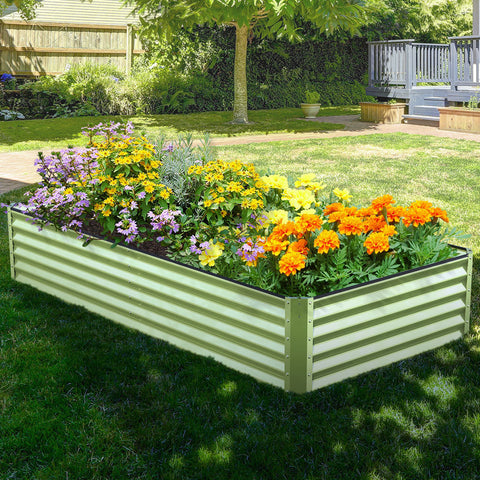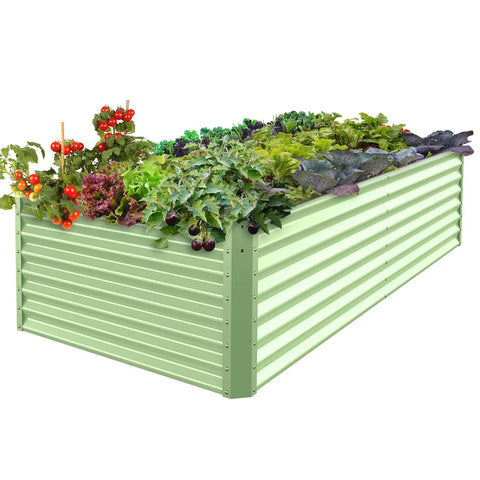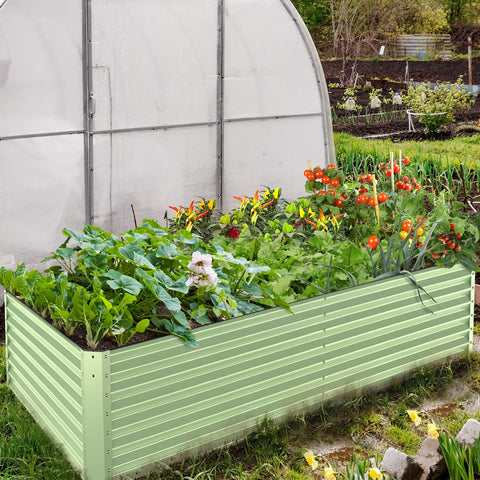When you're thinking about building an elevated garden bed, choosing the right wood is a crucial step. The choice of wood for elevated garden beds not only affects the stability and durability of garden beds, but also directly relates to the health and growth of plants. Before choosing the right wood for an elevated garden bed, it is crucial to understand the characteristics and advantages of different wood types. This article will give you a detailed overview of the important considerations in choosing wood for an elevated garden bed and explore which wood is best suited for use in an elevated garden bed. Let's start exploring!

Choosing the right wood for an elevated garden bed is crucial to creating a long-lasting garden. The right wood can provide a solid structure, good drainage and resistance to decay. Here is a detailed guide to choosing wood for an elevated garden bed.
1. Preferred wood type:
Pine: Pine is a common choice of wood for elevated garden beds due to its affordability, ease of processing and relative durability. However, pine is susceptible to decay and insect infestation, so it needs regular maintenance and control.
Teak: Teak is a strong and durable wood that is resistant to rot and pests. Teak has a higher price tag, but its natural durability makes it an ideal choice.
Oak: Oak is a hard and durable wood with excellent resistance to decay. However, oak has a higher price tag, so it may be suitable for those gardeners looking for a long-term investment and quality materials.
Wallboard (OSB board) : Wallboard is an affordable option, usually made from compressed and bonded wood chips. Although the wallpaper board is not as durable as solid wood, it can be used continuously under certain protection.
2. Types of wood to avoid:
• Filled wood: Filled wood refers to materials made using a combination of man-made materials, waste wood or wood pellet boards. These materials are usually not durable and perishable, making them unsuitable for elevated garden beds.
• Pressure treated wood: Although pressure treated wood has anti-decay properties, it often contains chemicals that are harmful to the environment and health. For environmental and health reasons, it is best to avoid using pressure-treated wood to build elevated garden beds.

3. Anti-corrosion treatment:
• In order to increase the durability of the wood, it can be treated with corrosion protection. Common anti-corrosion treatments include the use of chromium-free preservatives, acrylic waterproofing agents, or paraffin paints. These treatments extend the useful life of the wood and reduce the risk of decay and insect infestation.
4. Size and structure:
• Choose the right wood size and structure for your garden size and needs. In general, an elevated garden bed should be of sufficient height to accommodate the root system of the plant and allow you to easily operate and maintain the garden.
Before choosing wood, the following factors should also be considered:
Environmentally friendly: Choose wood from sustainable forestry to reduce environmental impact.
• Local climate conditions: Different woods have different adaptability to climate conditions. Choose the right kind of wood for the local climate to ensure the durability and stability of the elevated garden bed.

The most important thing is to choose high quality wood and carry out proper care and maintenance. Regularly inspect and repair any broken or rotting wood sections to ensure that the elevated garden bed remains strong and reliable at all times.
Choosing the right wood is crucial to building an elevated garden bed. It not only affects the structural stability and durability of the garden bed, but also directly related to the growth and health of the plant. By carefully considering the characteristics and advantages of different wood types, we can create a strong, durable and sustainable elevated garden bed.
Whether it's choosing affordable pine, durable teak or tough oak, we should choose the right wood for our needs and budget. At the same time, ensure that the wood is properly treated with corrosion protection to increase its durability and resistance to decay.

Before selecting wood, local climate conditions and environmental protection should also be considered. Choosing wood species that are adapted to the local climate ensures that the elevated garden bed will remain stable in all climates. In addition, choosing wood from sustainable forestry helps to reduce the negative impact on the environment.
Most importantly, the wood of the elevated garden bed is regularly inspected and maintained to ensure its stability and reliability. Repair any broken or rotten parts in a timely manner to extend the life of the raised garden bed.
By choosing the right wood, we can create a sturdy, durable, environmentally sustainable elevated garden bed that provides a healthy, thriving environment for our plants. May your elevated garden bed be full of life and beauty, bringing you harvest and joy!

Choosing the right wood for an elevated garden bed is crucial to creating a long-lasting garden. The right wood can provide a solid structure, good drainage and resistance to decay. Here is a detailed guide to choosing wood for an elevated garden bed.
1. Preferred wood type:
Pine: Pine is a common choice of wood for elevated garden beds due to its affordability, ease of processing and relative durability. However, pine is susceptible to decay and insect infestation, so it needs regular maintenance and control.
Teak: Teak is a strong and durable wood that is resistant to rot and pests. Teak has a higher price tag, but its natural durability makes it an ideal choice.
Oak: Oak is a hard and durable wood with excellent resistance to decay. However, oak has a higher price tag, so it may be suitable for those gardeners looking for a long-term investment and quality materials.
Wallboard (OSB board) : Wallboard is an affordable option, usually made from compressed and bonded wood chips. Although the wallpaper board is not as durable as solid wood, it can be used continuously under certain protection.
2. Types of wood to avoid:
• Filled wood: Filled wood refers to materials made using a combination of man-made materials, waste wood or wood pellet boards. These materials are usually not durable and perishable, making them unsuitable for elevated garden beds.
• Pressure treated wood: Although pressure treated wood has anti-decay properties, it often contains chemicals that are harmful to the environment and health. For environmental and health reasons, it is best to avoid using pressure-treated wood to build elevated garden beds.

3. Anti-corrosion treatment:
• In order to increase the durability of the wood, it can be treated with corrosion protection. Common anti-corrosion treatments include the use of chromium-free preservatives, acrylic waterproofing agents, or paraffin paints. These treatments extend the useful life of the wood and reduce the risk of decay and insect infestation.
4. Size and structure:
• Choose the right wood size and structure for your garden size and needs. In general, an elevated garden bed should be of sufficient height to accommodate the root system of the plant and allow you to easily operate and maintain the garden.
Before choosing wood, the following factors should also be considered:
Environmentally friendly: Choose wood from sustainable forestry to reduce environmental impact.
• Local climate conditions: Different woods have different adaptability to climate conditions. Choose the right kind of wood for the local climate to ensure the durability and stability of the elevated garden bed.

The most important thing is to choose high quality wood and carry out proper care and maintenance. Regularly inspect and repair any broken or rotting wood sections to ensure that the elevated garden bed remains strong and reliable at all times.
Choosing the right wood is crucial to building an elevated garden bed. It not only affects the structural stability and durability of the garden bed, but also directly related to the growth and health of the plant. By carefully considering the characteristics and advantages of different wood types, we can create a strong, durable and sustainable elevated garden bed.
Whether it's choosing affordable pine, durable teak or tough oak, we should choose the right wood for our needs and budget. At the same time, ensure that the wood is properly treated with corrosion protection to increase its durability and resistance to decay.

Before selecting wood, local climate conditions and environmental protection should also be considered. Choosing wood species that are adapted to the local climate ensures that the elevated garden bed will remain stable in all climates. In addition, choosing wood from sustainable forestry helps to reduce the negative impact on the environment.
Most importantly, the wood of the elevated garden bed is regularly inspected and maintained to ensure its stability and reliability. Repair any broken or rotten parts in a timely manner to extend the life of the raised garden bed.
By choosing the right wood, we can create a sturdy, durable, environmentally sustainable elevated garden bed that provides a healthy, thriving environment for our plants. May your elevated garden bed be full of life and beauty, bringing you harvest and joy!









